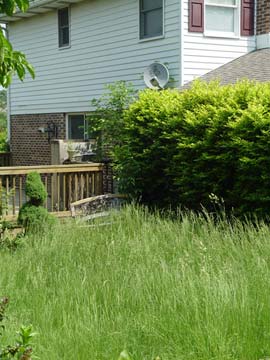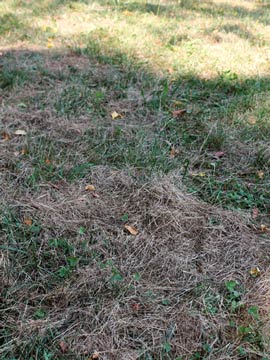Mowing is arguably the most underrated, overlooked part of good lawn care. Although the grass might be shorter when you’re done, there’s more to it than that. How you mow, when you mow and even what you do with the clippings can make a big difference in how your lawn performs.
These four mowing miscues are common:
 Cut grass higher. You may find it’s the evenness that makes it look good, not the short height.
Cut grass higher. You may find it’s the evenness that makes it look good, not the short height.
SimonSkafar / iStock / via Getty Images
1.) Cutting too short. Some lawn-owners scalp the lawn, using golf putting greens as their ideal, or cutting it short because they think they will have to mow less often.
Why that’s bad: Scalping increases moisture and nutrition demands as the grass tries to recover from near decapitation. Shorter blades mean less chlorophyll, which grass needs as a fuel source to rebuild. Short grass also allows the soil to dry out faster (bad news in drought), and weeds germinate better and get off to a faster start when taller grass blades aren’t in the way.
A better idea: Cut cool-season grasses about 3 inches high, or at least higher than what you’ve been doing. You might find that evenness is what makes a mown lawn look good, not its short height. The belief that cutting short lengthens the time between cuts doesn’t hold up, by the way. Grass actually grows faster after it’s been cut short as it tries to rebuild itself to its genetic norm.
Two exceptions to the cut-high rule: Before you overseed a lawn and toward the end of the season when a short cut helps head off moisture-related winter fungal problems.
 Don’t let turfgrass get very tall and then whack it back all at once.
Don’t let turfgrass get very tall and then whack it back all at once.
© George Weigel
2.) Not cutting often enough. This happens when people go away or try to cut down on mowing by letting the grass get very long, then whacking it way back.
Why that’s bad: Besides ending up with clogged mowers or mats of clippings, radical whackbacks are more stressful on grass than lighter cuts and require more energy to heal.
If you don’t remove clumps of cut grass, they’ll smother the living grass underneath.
A better idea: Mow often enough so you’re never removing more than one-third of the blade length at a time. This may mean mowing twice a week or every four or five days when grass is growing fastest in mid-spring.
3.) Bagging the clippings. Bagging mowers collect the clippings, which some people like because it keeps the lawn “neat” and because they think it prevents thatch, the spongy layer between the soil and the growing blades that can build up to problem thicknesses.
Why that’s bad: For starters, grass clippings don’t cause thatch buildups. More importantly, grass clippings are filled with nitrogen, minerals and important trace nutrients that the roots have mined from the soil. Letting them decay in place returns those nutrients to the soil instead of sending nutrients into the waste stream.
 Cut often enough that you don’t end up with clumps of clippings that can smother the growing grass underneath.
Cut often enough that you don’t end up with clumps of clippings that can smother the growing grass underneath.
© George Weigel
A better idea: If you mow often enough (see above), you’ll get small clippings that quickly disappear into the lawn, especially if you’re using a mulching mower. Researchers estimate that letting clippings decay supply one-quarter to one-third of a lawn’s total nitrogen needs for the season, which means you can save one fertilizer treatment a year. Decaying clippings also add organic matter to the soil.
4.) Cutting with dull blades. Few people keep their mower blades sharp. Some never sharpen them.
Why that’s bad: Dull blades make rough, ragged cuts that don’t heal as well as clean, sharp cuts, which increases the odds of disease. Ragged cuts also result in bigger tip openings that turn brown and stand out more than sharp cuts (i.e. it looks bad). Even worse, those bigger openings cause the grass to lose more moisture, which increases drought stress in hot weather.
A better idea: Follow the user manuals for almost every mower, and sharpen your mower blades once every 25 mowing hours – or more. At least shoot for two or three times a season. Some people own two different mower blades so they always have one for the mower while the other is being sharpened. A bench grinder and/or a metal file let you sharpen at home.
Six more tips to help you become an accomplished mower instead of a lawn butcher:
1.) If you fall behind in mowing, such as after a vacation or rainy spell, get back to the desired height by removing one-third of the blade height in two cuttings a few days apart rather than taking it the whole way down in one fell swoop.
2.) To limit raking if you’re getting noticeable clumps, mow around the perimeter of the yard, always shooting the clippings inward. You’ll end up having to rake only one or two channels in the middle.
3.) Avoid cutting the grass when it’s wet. The clippings are more likely to mat and/or clog your mower, and it’s harder to make an even cut when mower wheels are flattening wet grass blades. Also, you’ll likely compact the soil by walking or riding over it when wet.
4.) Avoid mowing when the lawn is going brown and dormant in a drought – even if you’re mainly doing it to mow off weeds. Grass crowns become brittle in drought, and if you smash them with your feet or mower wheels, they may not recover.
5.) Vary the route. You’ll get more even results by making sure no particular areas keep getting pushed down while others are always cut off when you go the same route every time. You can even make ornamental patterns a la sports fields by using a roller or cutting in a patterned direction. The color of the grass will look different depending on the direction it’s been mowed.
6.) If you have to stop and turn a lot, even out those areas by cutting your beds at broader, gentler curves. Also cut down on mowing around or bumping into trees by creating wide mulched or planted beds around them – and by joining several trees together in one larger, gently curving bed.